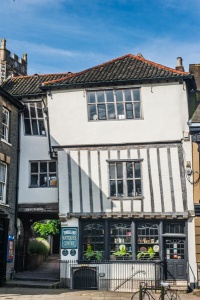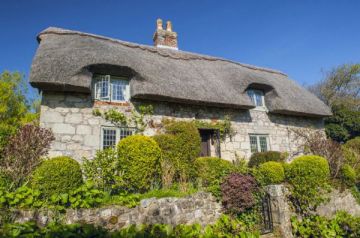
Steward led negotiations between the rebels and the king's army, and entertained the king's representative, the Marquis of Northampton, at his house. Some of Kett's more uncontrollable followers looted Steward's house, but did not harm him or his family.
They were not so restrained when they seized and killed Lord Sheffield and Sir Thomas Cornwallis (look for the plaque on the cathedral wall which marks the spot). When the Earl of Warwick came to finally suppress the rebellion he made his headquarters at Steward's house.

The house is a typical example of a Tudor merchant's town house, built with both commerce and living comfort in mind. There is a stone undercroft for goods storage, with a shop at street level. Family roos were on the upper storeys, jettied out over the ground floor to maximise floor space.
The timbers supporting the upper floors have warped and twisted over the centuries, making it look as though the house is in imminent danger of collapse. One projecting wing of timber and brick is set over the entrance to Tombland Alley.
On a corner stone of this projection, you can see the date 1549 and Steward's merchant's mark, along with the mercer's gild insignia. According to local legend, there are secret passages from the crypt to the Cathedral and to St Gregory's church. The house is also said to be haunted by the ghost of a woman who died in the plague of 1576.
There seems to be some confusion over the date the house was built. The commonly quoted date is 1530, but the 1504 will of Steward's father Geoffrey mentions the house as the place where Augustine was born. One possibility is that the house was damaged by a fire known to have swept through Tombland in 1507, and it was only rebuilt by Steward after he re-purchased the property.
Who was Augustine Steward?
Augustine Steward (1491 - 1571) was born in a house directly opposite the Erpingham Gate to Norwich Cathedral's Close in 1491. His father was a successful mercer and alderman, so Augustine, commonly called Austen, was born into a well-to-do family. Augustine apprenticed to his father until the latter died in 1504. His mother then remarried, to John Clerk, who was elected mayor the following year.

Augustine became a successful mercer in his own right, and re-purchased the house in Tombland where he was born. He married twice, and had 11 children in total. In 1522 he became a councillor, and alderman in 1526, and Sheriff the same year. He was elected mayor 3 times; in 1534, 1546, and 1556, a record matched by only 2 other men in the 16th century.
At that time the post of mayor was not a paid position, and the mayor was expected to finance civic functions at his own expense, so only people with flourishing businesses could afford to hold the post. To hold it 3 times, then, speaks volumes about just how wealthy Steward had become.
His achievements were recognised when the Corporation arranged an elaborate show to mark his third term as mayor. He also served as an MP in 1542 and a Burgess in Parliament in 1547.

along Tombland Alley
In 1534 Steward rebuilt the council chamber in the Guildhall, and he was instrumental in buying The Halls from the crown at the Dissolution. In fact, he appears to have paid the £81 fee for Blackfriar's Hall out of his own pocket.
His portrait hangs in Blackfriars. He owned huge swaths of property around Tombland, and estates in the Norfolk countryside. In later life, he moved into a new house on Princes Street, now occupied by numbers 20, 22, 24, and 26 (look for the plaque). He is buried in St Peter Hungate (now Hungate Medieval art).
Steward died in 1571 and his house went through a multitude of uses. It was a butcher shop, a bookshop, a broker's, and a coffee house, among other things. Today is house several antique dealers, which seems somehow rather appropriate given the outer appearance of the building.
Visiting
As the building is occupied by shops, you are limited to poking about inside during shop opening hours - please be polite to the shopkeepers! But even if you don't want to browse the antique shops, you can still get an excellent view both from Tombland and from Tombland Alley.
When you pass through the passageway to the alley, look for tool marks on the beams. The timbers were laid out on the ground and marked for assembly, rather like a giant jigsaw puzzle.

along the alley


the alley passage

house on Princes Street
About Augustine Steward's House
Address: 14 Tombland,
Norwich,
Norfolk,
England, NR3 1HF
Attraction Type: Historic Building
Location: Directly opposite the Erpingham Gate and Edith Cavell memorial in Tombland.
Location
map
OS: TG233088
Photo Credit: David Ross and Britain Express
NEARBY HISTORIC ATTRACTIONS
Heritage Rated from 1- 5 (low to exceptional) on historic interest
Erpingham Gate - 0 miles (Historic Building) ![]()
St George Tombland - 0 miles (Historic Church) ![]()
Hungate Medieval Art - 0 miles (Museum) ![]()
The Ethelbert Gate - 0.1 miles (Historic Building) ![]()
Norwich, St Michael at Plea - 0.1 miles (Historic Church) ![]()
The Halls - 0.1 miles (Historic Church) ![]()
Armada House - 0.1 miles (Historic Building) ![]()
Norwich Cathedral - 0.2 miles (Cathedral) ![]()
Nearest Holiday Cottages to Augustine Steward's House:
Spixworth, Norfolk
Sleeps: 2
Stay from: £255.00 - 1184.00
More self catering near Augustine Steward's House



